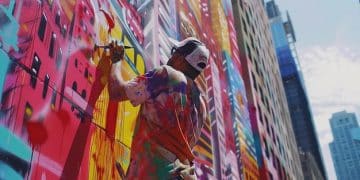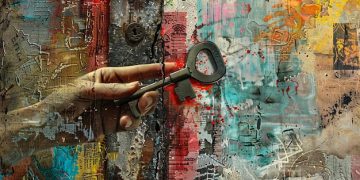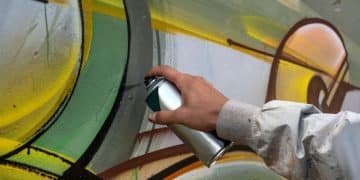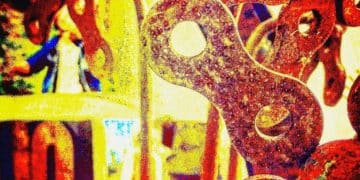Documenting & Preserving Graffiti Art: A US Artist’s Guide
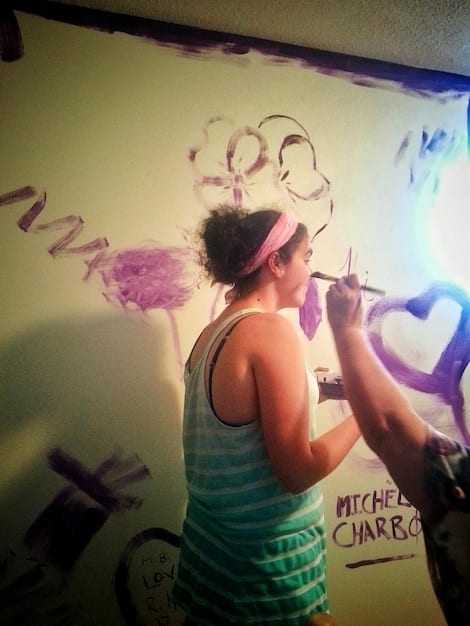
For US artists, effectively documenting and preserving graffiti art involves navigating a unique blend of photographic techniques, digital archiving, and ethical considerations to safeguard ephemeral beauty and historical significance.
For many, graffiti art is a vibrant, ephemeral expression, a fleeting moment of beauty on an urban canvas. But what happens when that art inevitably fades, is painted over, or removed? The challenge for US artists lies in how to effectively document and preserve their graffiti art, ensuring its legacy endures far beyond its physical lifespan.
The Impermanence of Graffiti: Why Documentation Matters
Graffiti art, by its very nature, is often impermanent. Created on walls, trains, or other urban surfaces, it’s subject to the elements, municipal cleanup efforts, or the artistic expressions of others. This transient quality, while part of its charm, also underscores the critical need for meticulous documentation. For US artists, understanding this impermanence is the first step towards building a lasting archive of their work.
Beyond personal remembrance, documenting graffiti serves several vital purposes. It creates a historical record, allowing future generations to study and appreciate the evolution of styles, techniques, and narrative themes within the movement. It also protects the artist’s intellectual property, providing tangible proof of creation, which can be crucial for exhibitions, publications, or even legal considerations in certain contexts. Without proper documentation, a significant body of artistic output could simply vanish, lost to time and circumstance.
Artistic Legacy and Attribution
The act of documenting your graffiti ensures that your artistic voice, your hand, and your vision are tied directly to the work, even when it no longer exists physically. This is especially important in an art form where anonymity has historically been a strong component. Attribution, however, becomes increasingly relevant in a digital age where images circulate widely, and proper credit is often overlooked.
- Establishes ownership and authorship of the artwork.
- Creates a permanent record for personal portfolios and historical archives.
- Facilitates showcasing work to galleries, curators, or potential clients.
- Supports claims for potential exhibitions, books, or academic studies.
Furthermore, the process of documentation itself can be an artistic act. Choosing how to frame a shot, the time of day, or the perspective can add another layer of interpretation to the original piece. It allows the artist to control the narrative of their work as it transitions from a physical entity to a digital or print artifact. This control is empowering, especially when the original work faces an uncertain future.
The urban environment constantly evolves, and graffiti art plays a significant, albeit often fleeting, role in shaping its visual landscape. By documenting these interventions, artists contribute to a broader understanding of urban culture, social commentary, and artistic trends. It’s a way of ensuring that the conversations initiated by their art continue, even as the specific piece recedes into memory.
Essential Photography Techniques for Graffiti Artists
Capturing the essence and detail of a graffiti piece requires more than just pointing and shooting. Photography is arguably the most crucial tool in documenting your graffiti art. The goal is to accurately represent the color, scale, texture, and context of your work. This involves a thoughtful approach to lighting, composition, and equipment, ensuring high-quality images that serve as a lasting record.
Lighting: The Golden Hour and Beyond
Natural light is often your best bet. The “golden hour” – shortly after sunrise or before sunset – offers soft, warm light that minimizes harsh shadows and highlights colors beautifully. Overcast days also provide excellent, diffused light, ideal for capturing uniform illumination across large murals. Avoid direct midday sun, which can create strong glare and blown-out highlights, obscuring detail. Experiment with different times of day to see how the light interacts with your piece and its surroundings.
- Golden Hour: Soft, warm light; ideal for rich colors and reduced shadows.
- Overcast Days: Even, diffused light; excellent for details and overall consistency.
- Avoid Midday Sun: Creates harsh shadows and glare, muting colors and detail.
- Artificial Lighting: For indoor or night shoots, use external flashes or continuous lights judiciously to avoid hotspots.
When working with artificial light, especially indoors or at night, be mindful of reflections and color casts. Using diffusers or bouncing light off surfaces can help create a more natural look. It’s also important to capture the entire piece without distortion, especially when dealing with curved surfaces or tight spaces.
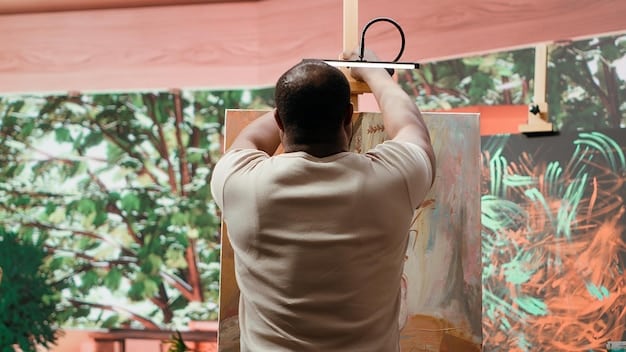
Composition and Framing
Your photographic composition should aim to showcase the artwork clearly while also providing context. Start with a full-shot that captures the entire piece, including its immediate environment, which helps convey scale and location. Then, move in for detail shots, focusing on particular characters, intricate lettering, or stylistic elements. These close-ups reveal the artist’s technique and the nuances that might be missed in a wider shot.
Consider the background and foreground. Are there distracting elements? Sometimes, incorporating elements like urban decay or passing pedestrians can add to the narrative, but often, a clean shot of the artwork itself is preferred for documentation purposes. Always try to shoot straight on to minimize perspective distortion, especially with long lenses. If shooting from an angle is unavoidable, consider using editing software to correct perspective later.
Camera Equipment and Settings
While a smartphone camera can work for casual shots, a DSLR or mirrorless camera offers greater control and quality. A wide-angle lens is useful for capturing large murals in tight spaces, while a standard prime lens (like a 50mm) can provide excellent sharpness and minimal distortion for individual pieces. A tripod is invaluable for ensuring sharp images, especially in low light or when bracketing exposures. Shoot in RAW format if possible, as it retains more image data for post-processing flexibility.
Pay attention to your camera settings: ISO, aperture, and shutter speed. Keep ISO as low as possible to minimize noise. Choose an aperture that gives you sufficient depth of field to keep the entire artwork in focus (often f/8 to f/11 for larger pieces), and adjust shutter speed accordingly to ensure a sharp image, using a remote shutter release if on a tripod. For outdoor shoots, a polarizing filter can reduce glare and enhance color saturation.
Mastering these photographic techniques ensures that your documentation captures the true essence and detail of your graffiti art, providing an accurate and visually appealing record for your archives.
Digital Archiving: Organizing and Protecting Your Artwork Files
Once you’ve captured high-quality photographs of your graffiti art, the next crucial step is to organize, store, and protect these digital assets. Digital archiving is more than just dumping files into a folder; it’s about creating a systematic, secure, and accessible repository for your artistic output. This forethought prevents loss, allows for easy retrieval, and ensures the longevity of your digital collection.
Naming Conventions and Metadata
A consistent file-naming convention is paramount. Consider including the date, location, title of the piece (if it has one), and your artist tag. For example, “YYYY-MM-DD_City_Location_ArtworkTitle_ArtistTag.jpg.” This makes files easily sortable and identifiable at a glance. Even more critical is embedding metadata into your image files. Metadata includes information like the date created, camera settings, copyright details, and keywords. Most photo editing software allows you to add this information directly to the file.
- Consistent Naming: Use a logical structure (e.g., date, location, title, artist tag).
- Add Keywords: Describe the style, themes, and techniques to improve searchability.
- Include Copyright Information: Protect your intellectual property rights.
- Geotagging: If applicable, embed GPS coordinates for location awareness.
Keywords are particularly useful for future searches. Think about terms someone might use to find your work: “abstract graffiti,” “character mural,” “new york street art,” “wildstyle lettering.” The more descriptive and accurate your metadata, the more discoverable your art becomes, not just for you but for anyone researching specific styles or regions.
Storage Solutions: Redundancy is Key
Never rely on a single storage location. The “3-2-1 backup rule” is a widely recommended strategy: keep three copies of your data, on two different types of media, with one copy offsite. This protects against hardware failure, accidental deletion, and even disaster. Cloud storage services provide a convenient offsite solution, while external hard drives offer local backups.
Options for storage include:
- External Hard Drives: Affordable for large volumes of data; susceptible to physical damage.
- Cloud Storage (e.g., Google Drive, Dropbox, Adobe Creative Cloud): Accessible from anywhere; regular subscription costs.
- Network Attached Storage (NAS): Personal cloud server; higher initial cost but full control.
- Archival CDs/DVDs (older method): Less common now, but still a form of offline backup.
Periodically check your backups to ensure data integrity. Technology evolves rapidly, so consider migrating your data to newer formats or storage devices every few years to prevent obsolescence. A proactive approach to storage ensures that your digital archive remains robust and accessible for decades to come.
Software and Workflow
Image management software like Adobe Lightroom, Capture One, or open-source alternatives like digiKam can greatly simplify your archiving workflow. These tools allow for efficient batch renaming, metadata editing, tagging, and cataloging. They also offer non-destructive editing, meaning your original files remain untouched. Developing a consistent workflow from capture to archive ensures that every piece of art is processed and stored uniformly.
Regularly review and cull your archive, deleting duplicate or subpar images to maintain a lean and effective collection. This digital housekeeping ensures that your archive serves its purpose as a comprehensive and accessible record of your artistic journey.
Physical Preservation: Beyond the Digital Realm
While digital documentation is invaluable, there are instances where physical preservation of graffiti art is attempted or necessary. This often involves either the removal and conservation of original fragments or the creation of physical replicas. The challenges are immense, from the scale of the artwork to the materials used and the ethical considerations of removing art from its original context. For US artists, understanding these avenues can broaden their approach to legacy, although direct involvement is often limited to specific, sanctioned projects.
Removing and Conserving Wall Sections
In rare cases, particularly with historically significant works or pieces commissioned for private property, sections of walls adorned with graffiti might be carefully removed and conserved for museum display or private collections. This is a complex and costly process requiring specialized conservation techniques to stabilize the artwork and prevent deterioration. Factors like the type of paint, the surface material, and environmental conditions all impact the feasibility and success of such operations. These projects are usually led by art conservators and institutions rather than the artists themselves.
- Specialized Expertise: Requires trained art conservators and structural engineers.
- High Cost: Due to labor, equipment, and material costs for removal and stabilization.
- Ethical Debates: Raises questions about the removal of public art from its intended context.
- Limited Scope: Only feasible for small, significant pieces or specific commissions.
The ethical implications of removing public art are often debated. Detaching a piece of graffiti from its original urban environment can strip it of its context and spontaneity, transforming it into a different kind of object. However, for some iconic works, removal is seen as the only way to ensure their long-term survival and accessibility for study and appreciation.
Replication and Reconstruction
Another approach to physical preservation involves creating high-quality replicas or reconstructions of graffiti pieces. This could range from large-format prints produced from the digital documentation to meticulously painted indoor versions of the original outdoor work. This method allows the essence of the work to be experienced physically without altering the original site, and it side-steps many of the ethical dilemmas associated with removal.
Replication can be particularly useful for exhibitions, allowing artists to present works that no longer exist. While not the “original,” a well-executed replica can convey the scale, color, and impact of the ephemeral piece. This process often involves the artist’s direct participation, ensuring accuracy and artistic intent are maintained. It also allows for the creation of new works inspired by past pieces, extending their lifespan in different forms.
Considerations for Materials
If an artist desires their work to be more durable on a physical surface, especially in sanctioned spaces, they might choose more resilient materials or protective coatings. UV-resistant paints, clear coats, or even indoor installation on prepared panels can extend the lifespan of a piece. However, these choices often move away from the traditional rapid, improvised nature of graffiti, bridging the gap between street art and gallery art. The core of graffiti art’s impermanence remains, making digital documentation the primary and most accessible path to preservation for most artists.
Legal and Ethical Considerations for US Graffiti Artists
The intersection of graffiti art with legality and ethics in the US is complex, fraught with varying interpretations and consequences. While documenting and preserving your work is crucial, it’s vital for US artists to navigate these waters responsibly. Understanding the legal status of your art, especially uncommissioned work, impacts how you document and share it, posing questions about intellectual property, permission, and anonymity.
Copyright and Ownership
Under US copyright law, original works of authorship fixed in any tangible medium of expression are automatically protected by copyright from the moment of creation. This includes graffiti art. However, this protection applies only if the work is created lawfully. Art created without permission (i.e., vandalism) complicates copyright claims. While an artist still technically “owns” the copyright to their illegal creation, enforcing those rights can be difficult and may even admit to the illegal act.
- Automatic Copyright: Your art is automatically copyrighted upon creation if lawful.
- Complications with Vandalism: Illegal creation compromises enforceability of copyright.
- “Moral Rights”: Some states recognize moral rights, protecting the integrity of the art.
- Documentation as Proof: Photography serves as a record of creation for potential claims.
Many US states also recognize “moral rights” for artists, which include the right of attribution and integrity, preventing distortion or destruction of their work. However, these rights often have specific conditions and are not universally applicable to all forms of street art, especially if the art is deemed to be on public property or was created without permission.
Permission and Public vs. Private Property
The most significant legal distinction for graffiti artists is whether the art is created with permission. Commissioned murals, art gallery installations, or pieces on legally designated “graffiti-friendly” walls are entirely lawful. Documenting these pieces poses no legal issue, and artists can freely share them without fear of self-incrimination. The property owner has granted permission, making the act legal.
Uncommissioned graffiti, however, is legally considered vandalism or property defacement. Documenting such art, particularly if it explicitly identifies the artist or the location, could potentially be used as evidence in legal proceedings. This is where artists often employ anonymity or carefully choose what details to reveal when sharing their work publicly. The trade-off between self-promotion and legal risk is a constant consideration.
Anonymity and Disclosure
For many graffiti artists, particularly those involved in illegal writing, anonymity is a crucial element of their practice and protection. When documenting and sharing their work, they often obscure faces, avoid revealing specific locations (especially addresses or recognizable landmarks), and use aliases. The power of the internet means that once an image is online, it can be tracked, and details can be inadvertently revealed.
Consider the implications of geotagging photos or posting images that clearly show personal features. While sharing your work is essential for building your artistic presence, doing so with a clear understanding of potential legal repercussions is vital. Some artists choose to wait until a piece has been painted over or removed before sharing its documentation, minimizing any immediate legal risk associated with its presence. The ethical considerations also extend to respecting the property boundaries and intended message of other artists, particularly when documenting collaborative pieces or works in active graffiti yards.
Showcasing Your Documented Art: Portfolios and Beyond
Once your graffiti art is meticulously documented and digitally archived, the next step is to put that work to good use. Showcasing your documented art effectively can open doors to new opportunities, from gallery exhibitions and commissions to collaborations and publications. A well-curated portfolio, both physical and digital, is your primary tool for sharing your artistic vision with the world.
Creating a Professional Portfolio
A portfolio is more than just a collection of images; it’s a narrative of your artistic journey and capabilities. For graffiti artists, a strong portfolio should showcase the breadth of your style, technique, and the scale of your work. Include clear, high-resolution images of your best pieces, noting dimensions, location (if permissible and legal), date of creation, and materials used. Organize your portfolio thoughtfully, perhaps by series, date, or theme, to demonstrate a cohesive artistic vision.
- Digital Portfolio: User-friendly websites (e.g., Behance, ArtStation, personal portfolio sites).
- Print Portfolio: High-quality prints in a professional binder for in-person meetings.
- Social Media: Instagram, TikTok, and Facebook for wide reach and dynamic content.
- Curated Selection: Only include your strongest and most representative works.
For a digital portfolio, consider building a dedicated website or using platforms like Behance or ArtStation that allow for high-quality image uploads and professional presentation. Ensure your website is mobile-friendly and loads quickly. For physical portfolios, invest in high-quality prints that accurately represent your work’s colors and details. A well-designed physical portfolio can make a strong impression in face-to-face meetings.
Leveraging Social Media and Online Platforms
Social media platforms are indispensable for graffiti artists. Instagram, in particular, serves as a visual diary, allowing you to share new work immediately and connect with a global audience. Use relevant hashtags to increase discoverability and engage with other artists and enthusiasts. TikTok can be used for behind-the-scenes content like time-lapses of creation or quick process videos.
While social media offers broad reach, remember to tailor your content to each platform. Short, engaging videos might work well on TikTok, while high-resolution static images are better suited for Instagram or a dedicated portfolio site. Many artists also use platforms like Flickr or Pinterest to organize and share their photographic archives with specific communities or for research purposes.
Networking and Exhibitions
Documented art is your calling card for networking. Attend art fairs, gallery openings, and street art festivals. Connect with curators, art dealers, other artists, and writers. Having a professional portfolio ready to share, either digitally or physically, is crucial when these opportunities arise. Documentation paves the way for your work to transcend the streets and enter more formal art spaces.
The ability to present a cohesive body of work, even if the originals are gone, demonstrates professionalism and commitment. It also allows you to tell a compelling story about your practice, enhancing your credibility and attracting collaborations, commissions, or sales of prints and merchandise. Your documented art becomes a powerful tool for self-representation and career advancement within the art world.
Future-Proofing Your Graffiti Art Archive
In a rapidly evolving digital landscape, ensuring your graffiti art archive remains accessible and viable far into the future requires proactive strategies. Future-proofing isn’t just about current backups; it’s about anticipating technological changes, evolving file formats, and the long-term needs of your creative legacy. For US artists, this means adopting habits that safeguard their artistic production against obsolescence and data loss.
Migration and Format Updates
Technology progresses, and file formats, while seemingly stable now, can become outdated or difficult to access. Think about floppy disks or older video formats. Regularly review your archive and consider migrating files to newer, more universally supported formats. For images, this often means ensuring you have high-resolution TIFF or lossless JPEG copies, and perhaps even DNG (Digital Negative) files, which are designed for long-term archiving by some camera manufacturers.
- Regularly review: Check file formats and storage media every few years.
- Migrate to current formats: Convert older, proprietary files to open, universally supported ones.
- Ensure open-source compatibility: Prefer formats that don’t rely on specific software licenses.
- Maintain raw files: Keep original raw camera files for maximum flexibility in future editing.
The goal is to avoid proprietary formats that might lock your data into a specific software product. Open-source formats offer more security for future access. As storage devices evolve, consider transferring your archived data to the latest, most reliable hardware. What’s cutting-edge now could be obsolete in a decade, so plan for periodic upgrades to your storage infrastructure.
Redundancy and Geographic Separation
Beyond the 3-2-1 backup rule, true future-proofing involves geographic redundancy. Storing backups in different physical locations (e.g., cloud storage in one region, an external drive at a relative’s house) protects against localized disasters like fires, floods, or theft. This significantly reduces the risk of total data loss and is a critical component of a robust archival strategy. Consider using multiple cloud providers for even greater peace of mind.
Automated backup solutions are highly recommended. Setting up software to automatically sync your files to external drives or cloud storage services on a regular basis minimizes the chance of human error and ensures that your archive is always up-to-date. Consistent, automated processes are far more reliable than manual, infrequent backups.
Ongoing Documentation and Curation
Future-proofing also requires a commitment to ongoing documentation. As your art evolves, so too should your archiving practices. Maintain a consistent workflow for new pieces, ensuring they are photographed, named, and archived according to your established system. Periodically review your existing archive to add new metadata, correct errors, or enhance descriptions. This continuous curation adds depth and value to your historical record.
Consider creating backups of your online portfolios and social media content. While platforms like Instagram host your images, relying solely on them is risky; platforms change, and accounts can be suspended. Download your data periodically from these services to ensure you have personal copies of everything you’ve shared. By taking these proactive steps, US graffiti artists can ensure their vibrant body of work lives on, appreciated by audiences and scholars for generations to come, long after the original walls have changed.
| Key Point | Brief Description |
|---|---|
| 📸 Document with Care | Use proper lighting and angles for high-quality, truthful representation of your artwork. |
| 💾 Archiving Essentials | Implement consistent naming, metadata, and the 3-2-1 backup rule for digital files. |
| ⚖️ Legal Awareness | Understand US copyright and property laws when documenting and sharing your work. |
| 🚀 Future-Proof Your Art | Proactively migrate formats and ensure geographic redundancy for long-term accessibility. |
Frequently Asked Questions About Documenting Graffiti Art
▼
Documenting graffiti art is crucial because of its inherent impermanence. Most graffiti is susceptible to weathering, cleanup, or being painted over, meaning a physical piece can quickly disappear. Documentation creates a permanent record, preserving its artistic, historical, and cultural significance for future study, exhibition, and personal archiving, maintaining the artist’s legacy.
▼
The best way is to use high-resolution cameras (DSLR/mirrorless) and pay close attention to lighting, preferably the golden hour or overcast days for soft, even light. Capture full shots for context and detailed close-ups. Focus on minimizing distortions, using a tripod for stability, and shooting in RAW format for maximum editing flexibility, ensuring accurate color and detail representation.
▼
Protecting digital files requires a robust backup strategy, like the “3-2-1 rule”: three copies of your data, on two different types of media, with one copy offsite (e.g., cloud storage, external hard drives, NAS). Use consistent naming conventions and embed metadata (date, location, copyright) for better organization and searchability, preventing data loss or issues.
▼
Yes, original graffiti art qualifies for automatic copyright protection in the US once fixed in a tangible medium. However, if the art was created illegally (e.g., without permission on private property), enforcing these copyright claims can be legally complicated and may inadvertently reveal the artist’s involvement in an unlawful act. Legal works have clearer copyright protections.
▼
Ethical considerations for documenting uncommissioned graffiti include respecting artist anonymity and avoiding revealing sensitive locations that could lead to legal repercussions. Many artists choose to obscure their identity or wait until a piece has been painted over before sharing documentation. Prioritize the safety and privacy of the artist while still preserving the artwork’s visual record.
Conclusion
Documenting and preserving your graffiti art is an indispensable practice for any US artist committed to honoring their creative journey and ensuring its enduring impact. From mastering photographic techniques to implementing robust digital archiving systems and navigating the intricate legal and ethical landscapes, each step contributes to building a powerful legacy. Your meticulous efforts transform transient expressions into permanent records, allowing your vibrant contributions to urban art to be studied, appreciated, and remembered for generations, long after the physical canvas disappears.
